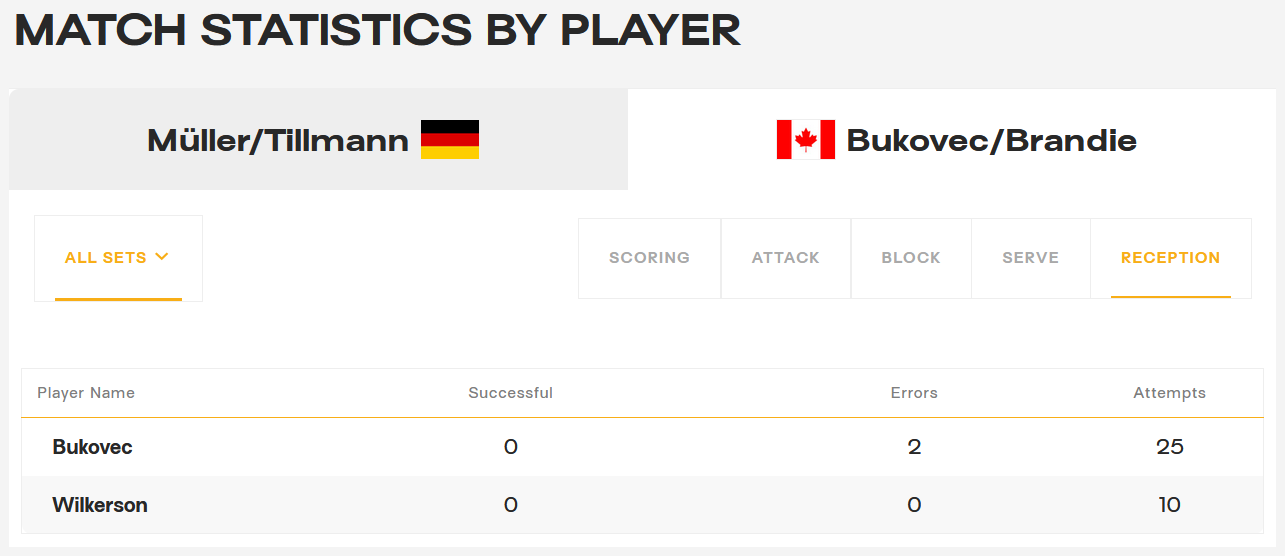Beach Week: World Champs Analysis
This week is Beach Week at Smarter Volley. I dedicate the first three weeks of each month to indoor volleyball and the fourth week to the beach game. If you are purely here for indoor volleyball, you might want to skip this one.
I haven’t published anything yet about the Beach Volleyball World Championships that took place earlier this summer. So, now’s a good time. We’ll hit some stuff from the women’s side of the game this week and circle back to the men’s side in September.
The match we’ll look at today is the women’s semifinal between the German pair of Muller and Tillmann vs the Canadian pair of Bukovec and Brandie.
First, let’s go to the Triangle:
Bukovec/Brandie v Muller/Tillman
+7 Terminal Serving
+3 Transition
-7 First BallClearly a big advantage in the Terminal Serving aspect of the game. Let’s see how the serving broke down:
Muller/Tillmann 48 Total Serves 11 Errors 2 Aces ---------- 44 Total Receptions 5 Times Aced Bukovec/Brandie 51 Total Serves 7 Errors 5 Aces ---------- 37 Total Receptions 2 Times Aced
Really high error rate for the German team here. 78% Serve-In is low. Sometimes aggressive serving backfires, and it particularly backfired here, because it only produced 2 aces. 5% aced rate is solid for the Canadians receiving. So high-error + low-pressure is a bad combination.
The Canadians were not necessarily conservative with their serving. 86% Serve-In isn’t remarkable one way or the other. Not nearly as high serve-in as the USA team we looked at previously. But forcing over 10% aced in their opponents is. So an average serve-in + high pressure is a path to success.
There’s some shades of that USA - NED match that we looked at previously in this one, where the team that won Terminal Serving also lost the First Ball battle, partly because their opponents missed a lot of serves, depriving them of First Ball opportunities.
But what I want to look at more is the Transition battle, because we’ll also look at that aspect of the game when we look at the men’s side of the World Championship bracket. With Germany winning the First Ball battle by as much as Canada won the Terminal Serving battle, you can argue that Transition was the deciding factor in this matchup.
What’s interesting here is the Transition production by Wilkerson. Since the beach side doesn’t have nearly the same amount of publicly-accessible data that the indoor game has, I’ll show how you can look at the FIVB box scores to produce some takeaways. Here’s a couple that caught my eye right away:
Okay, not a huge surprise here to see Bukovec take the majority of receptions. To target one player is common.
What’s uncommon here is to see the volume of both kills and total attempts that Wilkerson had, despite having relatively few receptions. You don’t often see a player have 5 more kills than total receptions! Bukovec had 23 receptions in play and only 26 total attacking attempts. Whereas Wilkerson had 10 receptions but 22 attacks.1
So with that in mind, we can go to the video and see the distribution and efficiency of those attacks.

So first of all, Wilkerson was automatic when she passed the ball. 8 of 9. But it’s worth noting the transition distribution is a lot different. “Dig” isn’t always the appropriate term here, as there were several times when Bukovec was dug out of reception leading to an overpass or easy ball that Wilkerson usually took.
What’s interesting is how these transition attacks played out in the match. 3 of Canada’s first 5 points were Transition kills by Wilkerson.
The play at 1-0 is a classic “good continue” by Bukovec. She gets dug, but they get a relatively easy ball back2 and then they put it right on-2 for the kill.
At 3-2, Wilkerson gets dug out of reception, and then we have a game of Beat The Puller to see who can win the rally in Transition.
And at 4-4 a classic finder ball at the net where you have to poke deep corner to win it.
Noteable that two out of those three transition kills came when Canada received. We know that the receiving team wins less than half of transition rallies, so winning transition rallies after you get dug is huge.
So Canada keeps pace in the early part of set 1 with some good transition play, and then the Terminal Serve game opened it up as they cruised to a win. Germany takes set 2 easily, which sets up set 3.
Terminal Serving was again a factor, as Bukovec opened it up with two straight aces. To be honest, I think the first serve was a pretty medium ball and I was surprised it produced an ace. But the next serve was a nasty dropper to put them up 2-0 in a 15-point set.
Germany makes a rare error in First Ball and then sides out. And at 3-1 Canada then puts up two more big transition kills to extend the lead.
Again, note that the first transition kill was with them receiving. Germany keeps the ball in play, but Canada is smooth on-2 for the kill. And they actually get too aggressive on the next play looking for the on-2 but then Bukovec makes a nice dig and puts the ball away to go up 5-1. They would protect that lead for the rest of the set and advance to the Final.
So 5 of their 9 transition kills were bunched up at the beginning of either the 1st or 3rd sets, helping swing both of them. We’ll look at some more transition play as the week continues.
The FIVB calls an “attempt” what I would call a “continue,” an attacked ball that is neither kill nor block.
Actually really nice job by Germany to get any sort of attack on it, but still, fairly easy.





